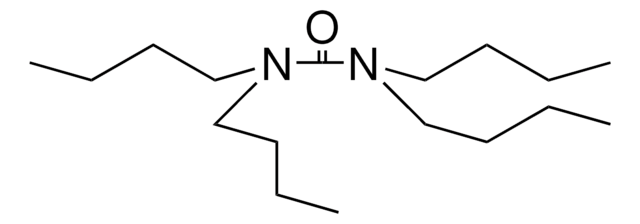471232
Dibutylamine
≥99.5%
Sinonimo/i:
N,N-Di-n-butylamine, N-Butyl-1-butanamine, n-Dibutylamine, Di-n-butylamine
About This Item
Prodotti consigliati
Densità del vapore
4.46 (vs air)
Livello qualitativo
Tensione di vapore
1.9 mmHg ( 20 °C)
Saggio
≥99.5%
Forma fisica
liquid
Temp. autoaccensione
594 °F
Limite di esplosione
10 %
Indice di rifrazione
n20/D 1.417 (lit.)
pH
11.1 (20 °C, 1 g/L)
P. eboll.
159 °C (lit.)
Punto di fusione
−62 °C (lit.)
Solubilità
water: soluble 3.8 g/L at 20 °C
Densità
0.767 g/mL at 25 °C (lit.)
Stringa SMILE
CCCCNCCCC
InChI
1S/C8H19N/c1-3-5-7-9-8-6-4-2/h9H,3-8H2,1-2H3
JQVDAXLFBXTEQA-UHFFFAOYSA-N
Cerchi prodotti simili? Visita Guida al confronto tra prodotti
Descrizione generale
Applicazioni
- N, N
- -Dibutyl-4-methylaniline by Pd-catalyzed Buchwald-Hartwig amination reaction with aryl chlorides and bromides.
- N,N-Dibutylacetamide by acetylation reaction with isopropenyl acetate.
It can also be used as:
- A strong hindered base in the different elimination reactions.
- An organocatalyst to synthesize annulated pyrano[2,3-d]pyrimidine derivatives via multicomponent condensation reaction of aromatic aldehydes, malononitrile, and barbituric acid.
Avvertenze
Danger
Indicazioni di pericolo
Classi di pericolo
Acute Tox. 2 Inhalation - Acute Tox. 3 Dermal - Acute Tox. 4 Oral - Eye Dam. 1 - Flam. Liq. 3 - Skin Corr. 1A
Codice della classe di stoccaggio
3 - Flammable liquids
Classe di pericolosità dell'acqua (WGK)
WGK 1
Punto d’infiammabilità (°F)
104.9 °F - closed cup
Punto d’infiammabilità (°C)
40.5 °C - closed cup
Dispositivi di protezione individuale
Eyeshields, Faceshields, Gloves, type ABEK (EN14387) respirator filter
Scegli una delle versioni più recenti:
Possiedi già questo prodotto?
I documenti relativi ai prodotti acquistati recentemente sono disponibili nell’Archivio dei documenti.
I clienti hanno visto anche
Il team dei nostri ricercatori vanta grande esperienza in tutte le aree della ricerca quali Life Science, scienza dei materiali, sintesi chimica, cromatografia, discipline analitiche, ecc..
Contatta l'Assistenza Tecnica.
















